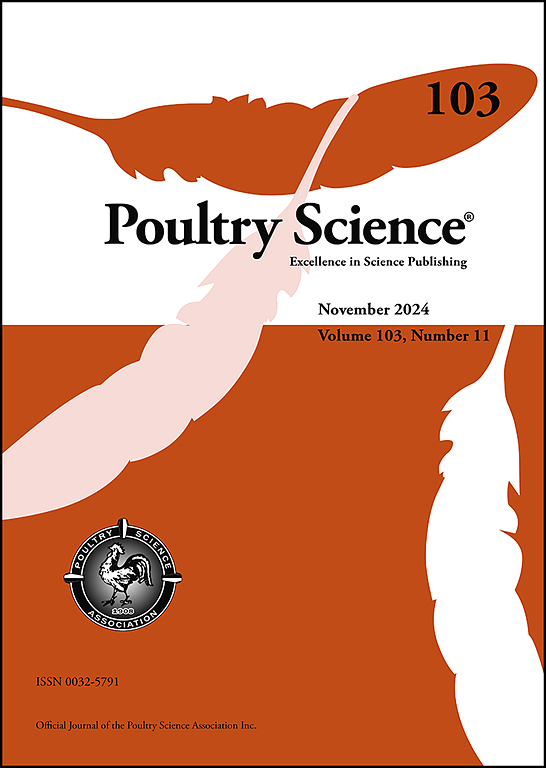一株重组鹅细小病毒的分离、鉴定、全基因组序列分析及致病性研究
IF 3.8
1区 农林科学
Q1 AGRICULTURE, DAIRY & ANIMAL SCIENCE
引用次数: 0
摘要
鹅细小病毒(GPV)是鹅瘟(GP)的病原,是一种影响鹅的急性出血性传染病,对家禽业构成重大的经济挑战。此外,最近的研究发现,新型鹅细小病毒(NGPV)是经典GPV的重组变体,是鸭短喙侏儒症的原因,严重影响了养鸭业。因此,GPV的感染和遗传进化引起了家禽疾病研究者的广泛关注。为了明确黑龙江地区临床重症GPV的流行情况和遗传进化,本研究成功从鹅胚中分离出一株GPV HLJ2023, 5代后死亡率为100%。电镜观察发现,病毒颗粒呈球形,直径约28 nm, HLJ2023株基因组总长度为5048 nt。SimPlot分析表明,HLJ2023株在VP3基因区与鸭细小病毒和NGPV密切相关。重组分析表明,分离株是NGPV JS191021株和GMD(鹅细小病毒)PT株的潜在重组株。HLJ2023株对雏鹅的致病性强。攻毒36小时后,雏鹅情绪低落,死亡率高达100%。尸检显示肠出血,肠壁变薄,肠腔内有大量纤维凝块和碎片。本研究分离出一株具有高致病性的重组GPV,进一步丰富了禽细小病毒的遗传进化和致病性信息。同时,该分离菌株为开发治疗GPV的生物制品提供了候选菌株。本文章由计算机程序翻译,如有差异,请以英文原文为准。
Isolation, identification, whole genome sequence analysis, and pathogenicity of a potential recombinant goose parvovirus
Goose parvovirus (GPV) is the etiological agent responsible for gosling plague (GP), which is an acute hemorrhagic infectious disease affecting geese, posing significant economic challenges to the poultry industry. Furthermore, recent studies have identified that the novel goose parvovirus (NGPV), a recombinant variant of the classic GPV, is responsible for duck short beak dwarfism syndrome, which has significantly affected duck farm. Therefore, the infection and genetic evolution of GPV have attracted widespread attention of researchers in poultry disease. In order to clarify the prevalence and genetic evolution of clinically severe GPV in the Heilongjiang region, this study successfully isolated a strain of GPV HLJ2023 from goose embryos, which results in the mortality rate of 100 % after 5 generations. The electron microscope shows that the virus particles are spherical, with a diameter of approximately 28 nm, and HLJ2023 strain has a total genome length of 5048 nt. SimPlot analysis showed that HLJ2023 strain is closely related to duck parvovirus and NGPV in the VP3 gene region. Recombination analysis showed that the isolated strain is a potential recombinant of the NGPV JS191021 strain and the GMD (Goose parvovirus hosted by Muscovy duck) PT strain. the strong pathogenicity of HLJ2023 strain to goslings. 36 h after the challenge, the goslings were depressed and had a mortality rate up to 100 %. Autopsy revealed intestinal bleeding, thinning of the intestinal wall, and a large amount of fibrous clots and fragments in the intestinal cavity. This study isolated a highly pathogenic potential recombinant GPV, further expanding the genetic evolution and pathogenicity information of avian parvovirus. At the same time, the isolated strain provides a candidate strain for the development of biological products for treating GPV.
求助全文
通过发布文献求助,成功后即可免费获取论文全文。
去求助
来源期刊

Poultry Science
农林科学-奶制品与动物科学
CiteScore
7.60
自引率
15.90%
发文量
0
审稿时长
94 days
期刊介绍:
First self-published in 1921, Poultry Science is an internationally renowned monthly journal, known as the authoritative source for a broad range of poultry information and high-caliber research. The journal plays a pivotal role in the dissemination of preeminent poultry-related knowledge across all disciplines. As of January 2020, Poultry Science will become an Open Access journal with no subscription charges, meaning authors who publish here can make their research immediately, permanently, and freely accessible worldwide while retaining copyright to their work. Papers submitted for publication after October 1, 2019 will be published as Open Access papers.
An international journal, Poultry Science publishes original papers, research notes, symposium papers, and reviews of basic science as applied to poultry. This authoritative source of poultry information is consistently ranked by ISI Impact Factor as one of the top 10 agriculture, dairy and animal science journals to deliver high-caliber research. Currently it is the highest-ranked (by Impact Factor and Eigenfactor) journal dedicated to publishing poultry research. Subject areas include breeding, genetics, education, production, management, environment, health, behavior, welfare, immunology, molecular biology, metabolism, nutrition, physiology, reproduction, processing, and products.
 求助内容:
求助内容: 应助结果提醒方式:
应助结果提醒方式:


